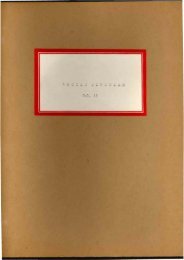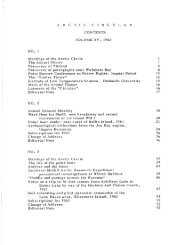Volume 4, 1951 - The Arctic Circle - Home
Volume 4, 1951 - The Arctic Circle - Home
Volume 4, 1951 - The Arctic Circle - Home
You also want an ePaper? Increase the reach of your titles
YUMPU automatically turns print PDFs into web optimized ePapers that Google loves.
Through the courtesy of the R.C.A~F. the party of<br />
three men, Dr. Y.O. Fortier and R. Tho~steinson~ both of<br />
the Department of Mines and~eohnical Surveys, and myself,<br />
were flown in to Resolute. <strong>The</strong> Air Force went to considerable<br />
trouble, because t.he transport of a 22-foot canoe,<br />
even in these days, is not an easy problem. <strong>The</strong> canoe Was.<br />
finally lashed into the bomb-bay of a Lancaster aircraft,<br />
and a reasonably cOmfortable trip was made to Resolute.<br />
Our party a~rived on June 1. and although spring<br />
was well advanced and open water was visible fifteen miles<br />
away in Lancaster Sound, we had to wait until July 17 to<br />
complete our final preparations for departure. <strong>The</strong> interval<br />
was filled in by a detailed survey of the Resolute area and<br />
in running several minor surveys for the various groups at<br />
the weather station.<br />
. On July 15 a very strong northeasterly gale,- accompanied<br />
by snow and sleet, commenced and lasted three and a<br />
half days. It was apparent that this heavy wind would clear<br />
the eastern approaches to Cornwallis Island and our party<br />
prepared to set out as soon as the gale abated. By early<br />
morning of July 21 we could ha reasonably certain of at<br />
least one calm day~ <strong>The</strong> canoe was therefore loaded, in<br />
fact overloaded, with 115 gallons of fuels, 1,500 pounds<br />
of food, and 1,500 pounds of personal and technical equipment.<br />
This outfit was intended to last us until September<br />
20, with an ample margin of safety. At last, at noon on<br />
July 21, we departed from Resolute Bay eastward.<br />
<strong>The</strong> sea was fortunately flat calm, and an easy run<br />
was made to Assistance Bay where a stop was made for lunch.<br />
<strong>The</strong> ships of Captain Penny and of Sir John Ross spent the<br />
winter of 1850-1 in this bay, and traoes of their stay,<br />
including piles of tin cans and the remains of a blacksmith's<br />
shop, could be seen on the eastern shore. Here,<br />
for lunch, we started our diet of K rations. <strong>The</strong>se rations,<br />
although perhaps monotonous for long periods, turned out to<br />
be Ideal for lunches and emergency snacks. After a cursory<br />
examination of the rocks in this vicinity, a start was once<br />
more made, and by 6 p.m. we had rounded Cape Hotham at the<br />
southeast corner of the Island. <strong>The</strong> cape, which in the<br />
early evening light was a most impressive sight, is formed<br />
by a bold bluff of limestone beds dipping 45 degrees eastward<br />
into the sea. A large landslide had occurred on the<br />
point and Thorsteinson, who had seen the slide at Frank,<br />
Alberta, considered that the slide here was quite as<br />
large.












